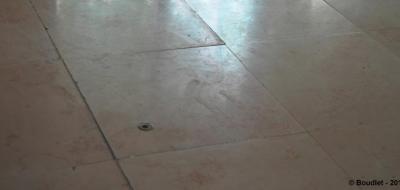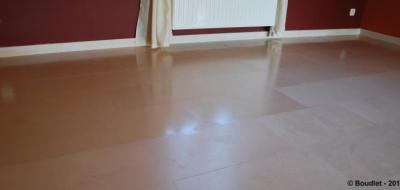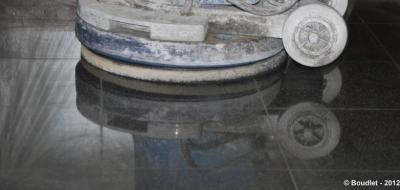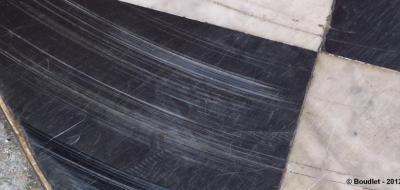Understanding the reasons of its renovation. This may seem trivial but is often a major component. Emotion Pierres provides a listing ear to meet your needs and always communicates clearly about what is possible or not for each case, to identify the best possible solution in terms of aesthetics, practicality and durability.
Here is a summary of the most important points to identify before finalizing the quotation.
The types of protection generally present, are waxes and polymers (emulsion, pore filler or resin). A simple way to verify their presence is to wet the floor. If the water doesn’t form a continuous film on the floor it means a protection is present.
It is then advisable to scrub the floor with a solvent and to verify if foam appears.
Another way to verify is to lightly sand the floor with emery paper. You must then verify if dust is formed or if there are scratches as on a plastic support.
If a protection is present, it is advisable to start with stripping before starting the renovation of the stone.
The gloss level of a floor is defined by the amount of light reflected in a coordinated way, that is to say the possibility to see an object by reflection on the floor. The simplest way to evaluate gloss is to use a light source ( a lamp or a window) and to verify if it is possible to see the reflection on the floor.
The more you have to go backwards ( to decrease the angle of reflection), the less your floor is glossy.
Depending on the gloss level and its homogeneity, it will be necessary to realize a treatment that is less or more important to achieve a brilliant gloss finish.
The stains can also be related to rising (often for light colored tiles) and are then very difficult or maybe even impossible to remove. Dry aggressive grinding can sometimes reduce the stains but it will always stay very difficult.
In case of brown stains, there are two main sources :
- The stains are only present on some of the tiles and stop on the edges. It is likely that these tiles contain pyrite crystals which converted in iron oxide in the presence of water (during cleaning).
- The stains are present on several tiles. The stains are due to the rising of ferruginous particles in the concrete screed.
Edges between tiles
The edges between tiles can be caused by poor installation or floor movement. In case of natural stone it is always possible to grind the edges through edge grinding. This step is necessary in case of grinding the floor. More info…

In case of stripping it is not necessary to grind the floor before applying a new treatment.
Two test can easily be performed to detect the presence of edges between tiles or tile floors :
- The coin test(or marble test) consists of rolling a coin or marble on the floor. If it doesn’t meet an edge, it will continue to roll.
- The test with a metal stick consists of placing a ruler on the floor. If it is perfectly stable, the floor is flat. If it can move or vibrate a little, there are edges between the tiles.
Depending on the level of scratches on the floor (and its wear), we will proceed to grinding the floor in a less or more important degree to make the scratches disappear completely before starting the gloss finish. More info…



